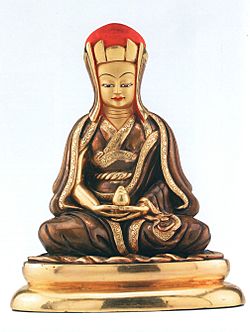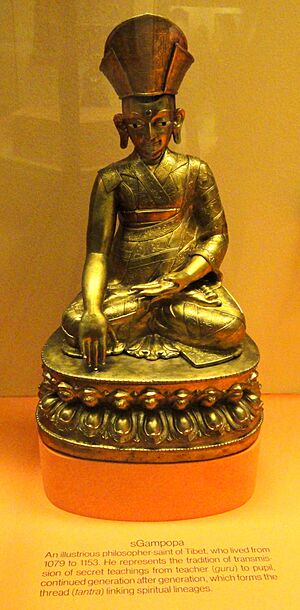Gampopa facts for kids
Quick facts for kids
Gampopa Sönam Rinchen
སྒམ་པོ་པ་བསོད་ནམས་རིན་ཆེན། |
|
|---|---|
 |
|
| Born | c. 1079 CE Budnyi Chedrak Serlung, Nyel valley, Gyaza dzong and Lung dzong, Tibet
|
| Died | c. 1153 CE |
| Occupation | Buddhist teacher, monk and philosopher |
| Known for | Founder of the Dagpo Kagyu school and Daklha Gampo monastery, teacher of sutra Mahamudra. |

Gampopa Sönam Rinchen (Tibetan: སྒམ་པོ་པ་བསོད་ནམས་རིན་ཆེན་, Wylie: sgam po pa bsod nams rin chen, 1079–1153) was a very important Tibetan Buddhist teacher. He was the main student of Milarepa, a famous yogi and poet. Gampopa helped organize Milarepa's teachings. These teachings became the basis of the Kagyu school of Buddhism.
Gampopa was also a doctor and a master of Tantra, which are special Buddhist practices. He wrote an important book called Jewel Ornament of Liberation. This book was the first of its kind, explaining the path to enlightenment step-by-step. He also started the Dagpo Kagyu school. People also knew him as Dvagpopa or Dakpo Lharjé, which means "the physician from Dakpo". Another name for him was Daö Zhönnu, meaning "Candraprabhakumara".
Contents
Gampopa's Life Story
Gampopa was born in a place called Nyal (or Nyel) in Central Tibet. From a young age, he studied medicine. He learned about Indian, Chinese, and Tibetan medical traditions. Later, he moved to the Dakpo region in southern Tibet. This is why he was also called Dakpopa, meaning "the man from Dakpo". The Gampo Hills are also nearby, which gave him his other name, Gampopa.
When he was young, Gampopa studied with different teachers. He learned from the Nyingma lama Barey and the Kadampa teacher Geshe Yontan Drag. He got married and had a child, but sadly, both his wife and child passed away. This sad event made him decide to become a monk.
In 1104, when he was 25, he became a monk. He received the name Sönam Rinchen. He joined the Kadampa lineage and focused on their teachings. In his 30s, he met Milarepa and became his most important student. Milarepa taught him special practices like Vajravārahī, tummo (inner heat meditation), and Mahamudra (a deep meditation practice).
The Mahamudra Teaching Lineage
Gampopa is a key part of the Mahamudra teaching lineage. This is like a chain of teachers passing down knowledge. Here are the main teachers in this lineage:
- Tilopa (988-1069): An Indian yogi who first experienced the Mahamudra teachings.
- Naropa (1016–1100): He improved the methods for quick enlightenment, known as his Six Yogas of Naropa.
- Marpa (1012–1097): The first Tibetan teacher in this lineage. He translated important texts into Old Tibetan.
- Milarepa (1040–1123): A famous poet and master. He achieved enlightenment in one lifetime.
- Gampopa: Milarepa's most important student. He combined the Kadampa teachings of Atiśa with Tilopa's Mahamudra teachings. This helped establish the Kagyü lineage.
These five teachers are known as the "Five Founding Masters" by the Kagyu school.
After studying with Milarepa, Gampopa founded Daklha Gampo Monastery in 1121 CE. He had many great students. These students were skilled in tantric practices, both monks and laypeople. Gampopa's teachings combined the step-by-step path of the Kadampa school with the deep meditation and tantric practices of the Kagyu school. He taught Mahamudra in two ways: a gradual approach and a sudden approach.
Dagpo Kagyu Schools
Gampopa taught many students, and his teachings led to the creation of several important Kagyu sub-schools. These are all part of the Dagpo Kagyu tradition. After Gampopa, there were "Four Major and Eight Minor" lineages of the Dagpo Kagyu School. This means they were founded in a certain order, not that some were more important than others.
The four "major" Kagyu schools were:
- Barom Kagyu: Started by Barompa Darma Wangchug (1127-1194?).
- Phagdru Kagyu: Started by Phagmo Drupa Dorje Gyalpo (1110-1170).
- Karma Kagyu: Started by Düsum Khyenpa, 1st Karmapa Lama (1110-1193).
- Tsalpa Kagyu: Started by Zhang Yudragpa Tsondru Drag (1123-1193).
Gampopa's own monastery was passed on to his nephew, Dakgom Tsültrim Nyingpo (Wylie: dwags sgom tshul khrims snying po, 1116-1169).
Gampopa's Teachings: The Four Dharmas
Gampopa taught a special set of ideas called The Four Dharmas in Brief. These are simple steps for spiritual growth:
- 1. Turning your mind towards the Dharma: This means thinking about how everything changes and doesn't last forever. When we die, we leave everything behind except what we learned from spiritual teachings. So, we should focus on the Dharma above all else.
- 2. Making the Dharma your path: This means using what you learn from the Dharma to guide your life. It's about putting the teachings into practice every day.
- 3. Using the path to clear up confusion: This means using your spiritual journey to understand things better. Gampopa said we need to get rid of confusion from top to bottom. This means understanding things deeply and clearly.
- 4. Turning confusion into wisdom: This is about how even our misunderstandings can lead us to greater wisdom. When we face confusion and work through it, we gain deeper insights.
These teachings are explained in other short texts by Gampopa. Many later teachers also wrote about them. They are also connected to another teaching called Parting from the Four Attachments.
Gampopa's Writings
Gampopa's collected writings are known as the Dags po'i Bka' 'bum. The original edition from Dvag Lha Gampo monastery is now lost. However, there are three main versions available today:
- One edition made in Hemis Monastery in Ladhak in the 1800s.
- A copy of that edition, published in India in 1982.
- The Derge wood block edition.
His book, The Jewel Ornament of Liberation (Wylie: dam chos yid bzhin nor bu thar pa rin po che'i rgyan), is one of his most important works. It has been translated into English twice. First by Herbert Guenther in 1959, and again by Khenpo Konchok Gyeltsen in 1998.
See also
 In Spanish: Gampopa para niños
In Spanish: Gampopa para niños
- Shri Singha
- Taklung Monastery

